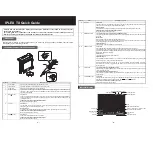
Section 3 — OPERATION
3–6
The indicated temperature (solid line) rises almost
instantly, depending on the response time of the
MODLINE 4, to follow the peaks in actual temper-
ature (dashed line) in the field of view. This
indicated temperature decays at a rate determined
by the setting of the Peak Picker Decay Time
control on the back panel. Fig. 3.3 shows the effect
of changing the decay time
To operate the Peak Picker, first place the Peak
Picker plug in its jack on the back panel, and if you
have wired an external switch to this plug, open
the switch for at least 15 seconds. This "dumps"
the peaking circuits and updates the circuitry to the
temperature being observed at the time. Close the
switch (or remove the plug from its jack) to place
the circuits in the Peaking mode
Adjust the Peak Picker Decay Time control to set
the desired decay time At the extreme
counterclockwise position is the fastest decay,
approximately 15 seconds for a full scale indicated
value to decay to zero scale if the source is
interrupted completely.
At the extreme clockwise position you will observe
the slowest decay rate, approximately 30 minutes
for full scale decay. Adjustment somewhere in
between these extremes will yield the decay you
need for your particular measurement situation.
This peak signal reading may be returned to the in-
stantaneous value at any time by opening the
external switch. This switch may be controlled
manually, or it may be operated by a microswitch
installed in the process or by a timer at desired
intervals. In the Direct mode the circuit follows
actual temperature variations as they occur.
NOTE: If you have not wired an external switch,
you can remove the Peak Picker Plug from its jack
to switch to the Peaking mode, and insert it in the
jack to switch to the Direct mode.
3.8
CLOSING THE ENCLOSURE
When all connections have been made, and when
you have adjusted all controls, place the cap on
the back panel of the enclosure to shield the con-
nections and protect the controls from tampering.
Align the thread of the cap with those on the back
panel of the enclosure. Then, tighten the cap by
hand. Use a bar or rod in the torquing slots (stan-
dard enclosure) or against the torquing studs
(water-cooled enclosure) to ensure a firm seal.
Summary of Contents for Modline 4
Page 3: ......
Page 5: ......
Page 6: ......
Page 34: ......
Page 35: ......
Page 36: ...Section 2 INSTALLATION 2 21 ...
Page 37: ...Section 2 INSTALLATION 2 22 ...
Page 49: ...Section 4 MAINTENANCE SERVICE 4 4 NOTES ...
















































